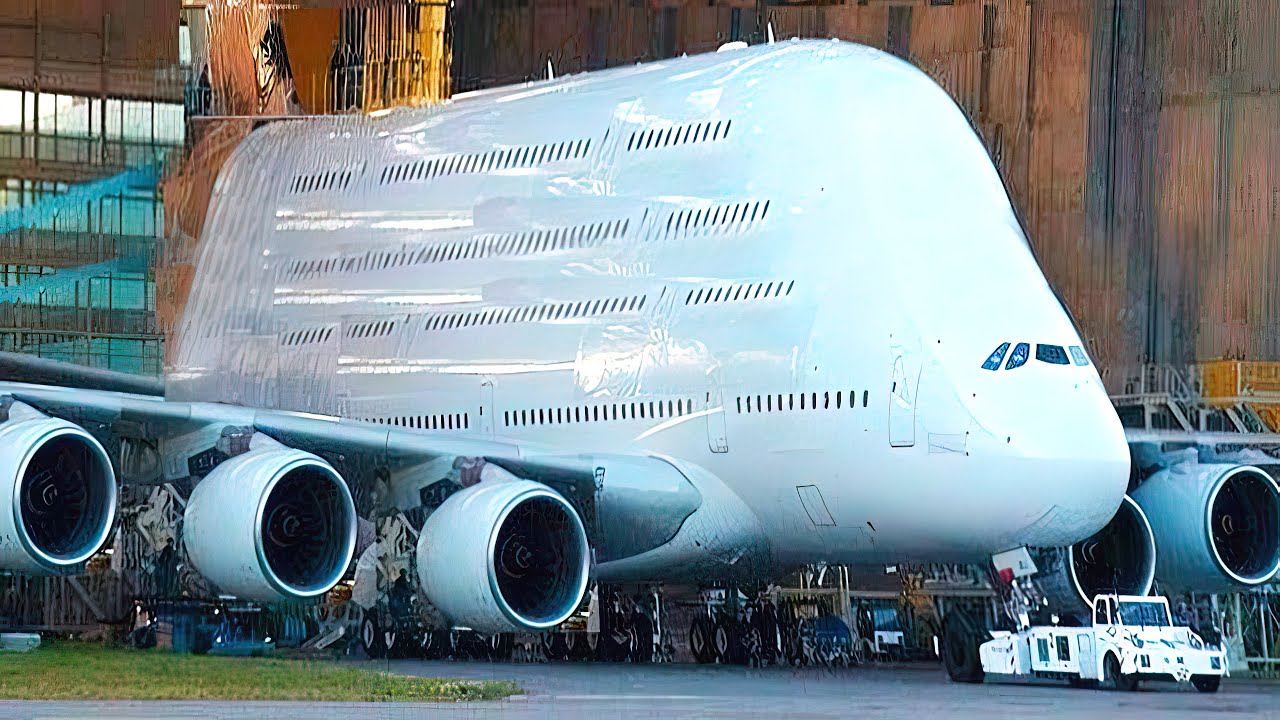Top 3 biggest airplanes in the world

These are the 3 biggest airplanes in the world
Antonov An-225 Mriya,
The Antonov An-225 Mriya is a strategic airlift cargo aircraft and currently holds the title of the largest airplane in the world. It was developed by the Ukrainian aircraft manufacturer Antonov Design Bureau in the 1980s and was primarily designed to transport the Soviet Union's Buran space shuttle and other heavy and oversized cargo.

Here are some key details about the Antonov An-225 Mriya:
-
Size and Dimensions: The An-225 Mriya has a length of 84 meters (275 feet 7 inches), a wingspan of 88.4 meters (290 feet 0 inches), and a height of 18.1 meters (59 feet 5 inches). Its maximum takeoff weight is around 640 metric tons (1.41 million pounds).
-
Payload Capacity: The aircraft's cargo hold measures 43.35 meters (142 feet 3 inches) in length, 6.4 meters (21 feet 0 inches) in width, and 4.4 meters (14 feet 5 inches) in height. It has a maximum payload capacity of 250 metric tons (550,000 pounds). The An-225 has a rear cargo door and a nose cargo door, allowing for flexible loading and unloading operations.
-
Engines: The An-225 Mriya is powered by six ZMKB Progress D-18 turbofan engines, each producing a thrust of around 51,600 pounds. These engines provide the necessary power to lift heavy cargo loads and propel the aircraft at a cruising speed of approximately 800 kilometers per hour (497 miles per hour).
-
Operational History: The An-225 Mriya made its first flight in 1988 and was primarily used for transporting the Buran space shuttle and other large payloads for the Soviet space program. Following the dissolution of the Soviet Union, the aircraft was put into storage for some time. However, it was later refurbished and returned to service for commercial cargo transportation.
-
Unique Features: The An-225 Mriya stands out due to its immense size and capacity. It features a double-deck fuselage, which allows for efficient cargo loading and can accommodate oversized cargo such as machinery, equipment, and even other aircraft. The aircraft's landing gear consists of 32 wheels arranged in a total of 14 main landing gear units, which distribute the weight evenly and enable it to operate from unprepared runways.
-
Current Operations: As of my knowledge cutoff in September 2021, the An-225 Mriya was operated by Antonov Airlines, a subsidiary of Antonov Design Bureau. It has been used for various commercial cargo operations, including transporting heavy machinery, equipment for oil and gas industry, humanitarian aid, and oversized cargo that cannot be carried by other aircraft.
It's important to note that the information provided is accurate up until September 2021, and there may have been updates or developments regarding the Antonov An-225 Mriya since then.
The Airbus A380 800,
The Airbus A380-800 is a double-deck, wide-body commercial aircraft manufactured by Airbus, a leading European aerospace company. It is the largest passenger aircraft in the world and was designed to compete with Boeing's 747 Jumbo Jet. The A380's development began in the 1990s, and the aircraft entered service in 2007.

-
Size and Capacity: The A380-800 has a length of 72.7 meters (238.6 feet), a wingspan of 79.8 meters (261.8 feet), and a height of 24.1 meters (79 feet). It can carry up to 853 passengers in a typical three-class seating arrangement, although airlines have different configurations that range from around 500 to 615 passengers. The spaciousness of the A380 allows for various onboard amenities, including bars, lounges, and spacious seating areas.
-
Double-Deck Layout: One of the most distinctive features of the A380 is its double-deck layout, which spans the entire length of the fuselage. The upper deck provides additional seating capacity and allows airlines to create premium cabins, such as first-class suites and business-class lie-flat seats. The lower deck typically accommodates economy-class passengers.
-
Fuel Efficiency: Despite its size, the A380 is designed to be fuel-efficient. It incorporates advanced aerodynamics, lightweight materials, and fuel-efficient engines, such as the Rolls-Royce Trent 900 or the Engine Alliance GP7000. These features help reduce fuel consumption per passenger, making it a more environmentally friendly option compared to older aircraft models.
-
Range and Performance: The A380-800 has a maximum range of approximately 8,000 nautical miles (14,800 kilometers), allowing it to operate on long-haul routes such as London to Sydney or New York to Hong Kong. Its cruising speed is approximately Mach 0.85 (around 900 kilometers per hour or 560 miles per hour).
-
Technological Advancements: The A380 incorporates numerous technological advancements for a smooth and comfortable flight experience. It features advanced avionics, fly-by-wire flight controls, state-of-the-art entertainment systems, and enhanced passenger comfort with reduced noise and improved cabin pressurization.
-
Impact on Airports: Due to its size, the A380 requires specific infrastructure at airports. It needs dedicated double-deck boarding gates and large parking areas. Some airports made modifications to accommodate the A380, while others faced challenges due to its size and limited demand.
-
Market and Challenges: The A380 faced challenges in the market, primarily due to changing airline preferences and market dynamics. High operational costs, increased competition from smaller, long-range aircraft, and reduced demand for ultra-large aircraft contributed to Airbus announcing the end of A380 production in 2019. However, many airlines continue to operate the A380, and it remains an iconic symbol of aviation engineering.
It's important to note that while the information provided here is accurate as of my knowledge cutoff in September 2021, there may have been updates or developments regarding the A380-800 since then.
Boeing 747-400,
The Boeing 747-400 is a wide-body, four-engine commercial aircraft developed by Boeing Commercial Airplanes. It is part of the Boeing 747 family, which has been in operation since its first flight in 1969. The 747-400 is the most recent variant of the 747 series and incorporates various improvements over its predecessors.

Here are some key features and characteristics of the Boeing 747-400:
-
Design and Capacity: The 747-400 has a distinctive hump-shaped upper deck, which extends along a significant portion of the fuselage. This upper deck provides additional cabin space and allows for more passenger seating or the inclusion of other amenities. The aircraft has a typical seating capacity of around 416 passengers in a three-class configuration, although it can vary depending on the airline's specific layout.
-
Range and Performance: The 747-400 has an impressive range of approximately 7,260 nautical miles (13,450 kilometers) and can fly non-stop on long-haul routes, such as transoceanic flights. It is powered by four high-bypass turbofan engines, typically using Pratt & Whitney PW4000 or Rolls-Royce RB211 engines. These engines provide improved fuel efficiency and reduced noise levels compared to earlier 747 models.
-
Cockpit and Avionics: The flight deck of the 747-400 features advanced digital avionics and a glass cockpit, which significantly reduces the number of traditional analog instruments. It incorporates electronic flight instrument displays, flight management systems, and other modern technologies to enhance flight safety, efficiency, and crew coordination.
-
Freighter Variant: In addition to the passenger version, the 747-400 is also available as a freighter model. The freighter variant is popular among cargo airlines and can carry a substantial payload over long distances. Its large nose cargo door allows for easy loading and unloading of oversized cargo.
-
Historical Significance: The Boeing 747, including the 747-400, holds a significant place in aviation history. It revolutionized air travel by introducing the concept of the jumbo jet, providing increased capacity and range compared to previous aircraft. The 747 became a symbol of international air travel and played a vital role in shaping the global aviation industry.
However, it's worth noting that as of my knowledge cutoff in September 2021, Boeing had discontinued production of the 747-400 and shifted its focus to more modern models like the 747-8. The 747-400 remains in service with several airlines, but many have started replacing it with newer, more fuel-efficient aircraft.
Please keep in mind that there may have been developments or changes in the aviation industry since my knowledge cutoff, so it's always a good idea to refer to the latest official sources or Boeing's website for the most up-to-date and accurate information.








